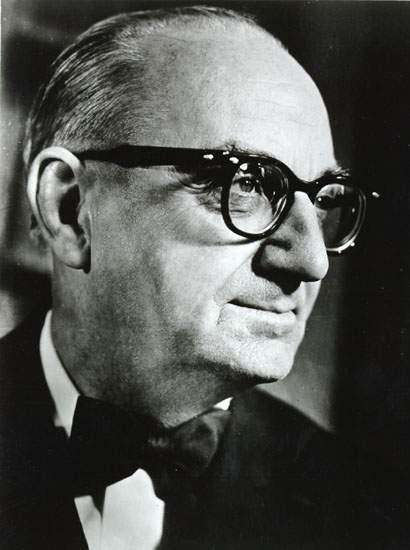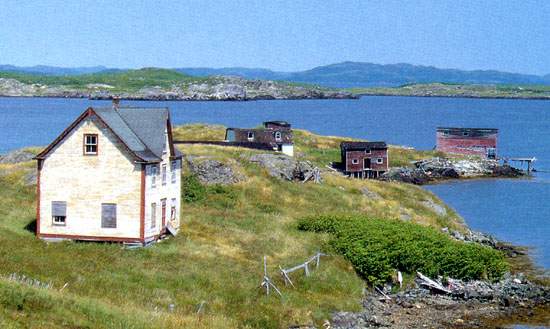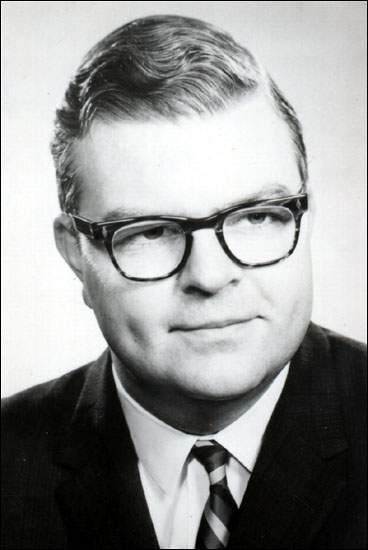Provincial Government: The Smallwood Years, 1949-1972
When Newfoundland and Labrador joined the Canadian federation just before midnight on 31 March 1949, a form of responsible government came into operation, but somewhat different from that which had existed prior to 1934. It remains the same today.
The Crown's representative is a lieutenant-governor effectively appointed by the Government of Canada, rather than a governor appointed by the British government. The Legislative Council disappeared, so the legislature since 1949 has consisted only of the House of Assembly. The leader of the largest party in the Assembly is appointed premier, and selects the other members of the Executive Council or cabinet. The government remains in office for four years, or until a general election is called. The people of the province have a small voice in setting federal policy. Newfoundland and Labrador has seven representatives in the House of Commons and seven Senators, and by convention at least one Newfoundlander is appointed to the federal cabinet.
Terms of Union
The Terms of Union between Canada and Newfoundland followed the general lines of the British North America Act of 1867. They set out which areas of government fell under federal, and which under provincial jurisdiction. Fisheries, criminal law and banking, to take three examples, became federal responsibilities. The province retained control over areas that did not have a direct effect upon other provinces, such as health care, social services and education.
There have been periodic tensions between the two levels of government over questions of jurisdiction - the question of who owned the resources on the continental shelf is a prime example. The collapse of the cod fishery in the 1990s convinced many Newfoundlanders that the provincial government should have had jurisdiction over offshore resources. As divisive as some of these issues proved to be, the principal flaw in the confederation terms has been the financial arrangements. Before Confederation, the Newfoundland government had depended on customs duties as the principal source of revenue. After 1949 this became a federal tax area, as did income taxes. Yet three of the most expensive fields of responsibility - health care, social services and education - were left to the province. The problem was exacerbated by the new province’s relatively small tax base - that is, its limited ability to generate enough government income.
When negotiating the Terms of Union, both sides recognized this dilemma, and attempted to rectify the situation in two ways. There would be a special transitional grant to the new province for the first eight years, while it made its taxable capacity similar to that in the Maritime Provinces. This grant would then be subject to review by a Royal Commission, under the clause known as Term 29. Second, the Province of Newfoundland would receive transfer payments from the federal government according to the formula that applied across the country. The large portion of the province's revenue that came in the form of transfers from Ottawa was a source of embarrassment and even with the federal money the province's expenditures often outstripped its revenues.
The Liberal Regime of J.R. Smallwood
On the date of union, the federal government appointed a lieutenant-governor, Sir Albert Walsh. He then invited Joseph R. Smallwood to form an interim government until the first provincial election could be held. Smallwood had led the campaign for confederation and had helped to negotiate the Terms of Union. He quickly established a provincial branch of the Liberal Party of Canada - also the majority party in the Canadian Parliament - with himself as leader. Smallwood's anti-confederate opponents, as a result, became Progressive Conservatives. The third federal party, the Commonwealth Cooperative Federation (later the New Democratic Party) was unable to find a foothold.

As premier, Smallwood had many advantages in the first election campaign. Federal government transfers to individuals, such as the child benefits and old age pensions, were now extended to Newfoundlanders and Labradorians, and Smallwood took personal credit for the cash flowing into many households. Most candidates running for the Conservatives had opposed confederation, and seemed to be fighting a battle they had already lost. The victorious Liberals dominated island constituencies outside the Avalon Peninsula and Labrador, which had been confederate areas in the 1948 referendums. The Conservatives won seats in former anti-confederate strongholds in St. John's and elsewhere on the Avalon Peninsula. This pattern of rural support for the Liberals, and Conservative support in St. John's and the capital region lasted through subsequent elections, and helped Smallwood and the Liberals to remain in power for the next 22 years.
New Industries and Modernization
Smallwood wanted to create an industrial economy, and encouraged foreign capitalists to invest in the development of new industries. Making use of the connections of the Latvian-born Director of Economic Development Alfred Valdmanis, the government enlisted the help of a number of German industrialists to open factories in the 1950s. Though backed by the provincial government, there were few successes and Valdmanis admitted having solicited bribes from would-be investors. The failures and corruption did much to diminish Smallwood's reputation. This was followed by larger projects that Smallwood hoped would kick start industrial development. But his government's support for a third pulp and paper mill in Stephenville, and an oil refinery in Come By Chance, for example, resulted in large costs to the taxpayers and disappointing results. The same can be said of the gigantic Churchill Falls hydro-electric development in Labrador, where it soon became apparent that under the terms of a long-term sales agreement, most of the profits would go to the Québec-owned utility, Hydro-Quebec.

The Liberal government also spent large amounts of money on infrastructure - roads, schools, hospitals and electrification, for example - that would "modernize" the province. This investment was badly needed, and improved the quality of people's lives. However, in order to provide adequate services to everyone, the government implemented controversial resettlement programmes. These were designed to move people from small, remote settlements to "growth centres", where employment would be available on the trawlers and in the fish plants spawned by an industrialized fishery. The jobs in these growth centres proved elusive, and many people resented the heavy-handed approach the government had used to force people out of their home communities.

The Smallwood government's first major crisis erupted in the late 1950s. At home, Smallwood - who had been a socialist - bitterly attacked the International Woodworkers of America, a union which was organizing loggers in central Newfoundland and had supported their strike for better pay and conditions of work. Though Smallwood managed to rally support locally for his anti-IWA campaign, the Conservative government in Ottawa was unwilling to send police reinforcements, and a bitter war of words followed. Smallwood's reputation as a friend of labour had ended. This dispute also coincided with the review of the province's financial position mandated by the Terms of Union. The provincial government was outraged at a financial offer which was far lower than it had expected, and a serious rift developed between the two governments - demonstrating that Smallwood could not always deliver generous assistance from Ottawa.
In spite of all these disputes and difficulties, Smallwood personally dominated the provincial political scene during the 1950s and 1960s. He chose the Liberal candidates for provincial ridings, practically determined the province's representation at Ottawa, and manipulated patronage to Liberal advantage. Within the cabinet, he tolerated no dissent. It was a highly personal government, and Smallwood himself called the regime a “democratic dictatorship.” Smallwood's opponents, whether disaffected Liberals or members of other political parties, proved to be ineffective.
Political Changes, 1968-1972
By the late 1960s, though, the political scene was changing. Since the Conservatives in the House of Assembly were ineffectual and Smallwood effectively muzzled dissent within the Liberal party, the press and the university community became the only opposition. Former Smallwood ally Harold Horwood had earlier criticised Smallwood's development strategy in the St. John's Evening Telegram. In the same newspaper, Ray Guy's satirical columns now made insulting fun of Smallwood and his cabinet and - importantly - appealed to Newfoundlanders and Labradorians to remember their distinctive traditions and identity. Guy's columns made Smallwood a figure of fun rather than someone to be feared, and helped galvanize a new generation of politicians to challenge Smallwood's hegemony over government. His jibes appealed to a new generation which came of age after the Confederation wars, and which was becoming deeply concerned about its dual Canadian-Newfoundland identity. While faculty at Memorial criticised such heavy-handed programs of social engineering as the Resettlement Program, many students turned to the Tories in hope that they could spark a generational change in provincial leadership.
Smallwood attempted to revitalize his party by bringing into the cabinet younger men with considerable talent - such as John Crosbie, Clyde Wells, Edward Roberts and others - but he was unable to relinquish power, and few of these people remained in the cabinet, and under Smallwood's control, for long. There were setbacks in his economic development programme and the Liberals lost seats in the 1968 federal election and in a provincial by-election in Gander. Smallwood announced his retirement in 1969, but he could not bring himself to relinquish power, particularly to the front-runner, John Crosbie, who had earlier resigned from caucus. Smallwood therefore ran for the leadership. A remarkably bitter leadership contest pitted the younger generation, which supported Crosbie, against an older generation of Smallwood loyalists. Although Smallwood won on the convention floor, many Liberals defected to the Conservatives rather than remain in Smallwood's party.

During this period the Progressive Conservatives emerged as a genuine alternative government. No longer tarred as anti-confederates, and attracting able candidates with impeccable credentials - such as Crosbie and Frank Moores - there was a real chance that the Opposition could break the Liberal supremacy.
The 1971 provincial election was a hard-fought contest between Smallwood and those who wanted to remove him from power at long last. The result was uncertain and contested. Twenty-one Conservatives were elected to 20 Liberals, with one independent. Smallwood refused to resign while judicial recounts and the prospect of members changing party allegiance held out the hope that he could hold on to power. Another provincial election of 1972 returned a clear majority for the Progressive Conservatives under the leadership of Frank Moores. Although he attempted a return to political life in 1975, Smallwood's personal hegemony had ended.
J.R. Smallwood was the dominant figure in 20th century politics. He used his close relationship with the federal Liberal government to ensure a flow of both federal and provincial patronage that bolstered his personal hold on power. But when the Conservatives were elected federally in 1957, Smallwood was no longer able to deliver federal programs as if they were his own and a new generation of potential leaders was unwilling to do nothing while Smallwood monopolized power. The period between 1968 to 1972 marked a generational shift, as well as a significant change in political style.




